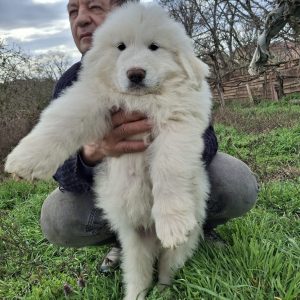
Great Pyrenees
Armed with its awesome size, long, white coat, and a spiked collar, the Pyrenees dog has been facing off bears and wolves while guarding their master’s flocks of sheep for a very long time. If not used for guarding duties, Pyrenees dogs should be socialized as early as possible with other people and dogs. Pyrenees dogs are very independent and might come across as aloof, making them one of the more difficult breeds to train. The Pyrenees gets very attached to the family or flock that it dedicates its life to. Gentle and affectionate with its family, the Pyrenees is mistrustful of strangers, whether human or canine. The Pyrenees should not be housed in apartments. These dogs’ dense coats makes them unsuitable for warm climates.
Great Pyrenees breed attributes
About Great Pyrenees breed
Description
Armed with its awesome size, long, white coat, and a spiked collar, the Pyrenees dog has been facing off bears and wolves while guarding their master’s flocks of sheep for a very long time. When compared to the rest of its body, the Pyrenees’ head is not as hefty as in other molossoid breeds. Its round skull slopes gently into a broad, bluntly tapering muzzle. Despite this breed’s head being daintier than in other similar breeds, the Pyrenees’ lightly drooping lips cover a complete set of strong teeth that clench shut into an unforgiving pincer bite or scissor bite. Its small, almond shaped eyes make the dog look as if it’s lost in thought. A pair of small, blunt, triangular ears sprout out of the sides of the dog’s skull at eye level.
The Pyrenees’ short neck is strong, and the dog’s slightly elongated body houses a deep, broad chest that gives an impression of great volume. The dog’s broad withers, and muscular hindquarters and buttocks anchor the body to the Pyrenees stable, strong legs that plant themselves perpendicular to the ground. The Pyrenees’ conformation should not compromise suppleness for stability, but it should have a good amount of both. Its strong, bushy tail forms a plume and should fall down to the hock when the dog is not excited.
Origin: France
Look
The Great Pyrenees has a thick double coat that is made up of a long, supple top coat and a thick, fleecy undercoat. Both coat types are very easy to maintain. The coat is longer on the tail and around the neck.
The colour of the Pyrenees’ coat comes in solid white, or white with patches of light grey, yellow or orange on the head, tail and sometimes body.
Regular brushing is needed in order maintain this breed’s coat in top form. The Pyrenees should be brushed more frequently when it is shedding its dense undercoat once yearly.
Health
The Pyrenees is generally considered to be a healthy breed. However, some health conditions are still associated with it. These are:
- Hip dysplasia.
- Bone cancer.
- Patellar luxation.
- Dermatologic problems.
It is recommended that Great Pyrenees dogs visit a veterinarian at least once yearly. Pyrenees puppies must also get their knees radiographed and hip scores evaluated in order to determine the condition of their knees and hip joints. Strict monitoring of a Pyrenees dog’s diet ensures that the dog does not add unnecessary weight that might increase the severity of an already existing hip dysplasia or patellar luxation. Feeding small meals three times daily and letting the dog rest after meals will also reduce the possibility of stomach torsion that might develop into life-treating bloat.
At Newdoggy.com we promote puppies coming from reputable breeders, who use genetic testing and good breeding practices to remove genetic conditions from their breeding lines. Newdoggy.com’s Health Guarantee certifies that all promoted puppies are in good health.
Learning
If not used for guarding duties, Pyrenees dogs should be socialized as early as possible with other people and dogs. Pyrenees dogs are very independent and might come across as aloof, making them one of the more difficult breeds to train. Calm, confident owners that know when to be assertive are the ones that manage to bring out the best out of this breed. Besides being used as property or flock guardians. Pyrenees dogs can also be trained as avalanche dogs and used as pack dogs.
Temperament
The Pyrenees gets very attached to the family or flock that it dedicates its life to. Gentle and affectionate with its family, the Pyrenees is mistrustful of strangers, whether human or canine. Its independent nature can be mistaken for stubbornness, and Pyrenees can sometimes wander away when off leash. Territoriality comes natural to this breed, and it will not tolerate new dogs and people unless introduced properly. These dogs do surprisingly well with cats as they do not perceive them as a threat. This breed might become destructive if not sufficiently exercised.
Living with
The Pyrenees should not be housed in apartments. Pyrenees dogs are also known to be very vocal and this might disturb other people living in the same block of flats. This breed of dog does best in a spacious house with unrestricted access to a reasonably sized, fenced yard. These dogs’ dense coats makes them unsuitable for warm climates.
Find Great Pyrenees Puppies for Sale
New litter alert
Please fill in the below form and we will let you know when a new Great Pyrenees litter arrives.
















